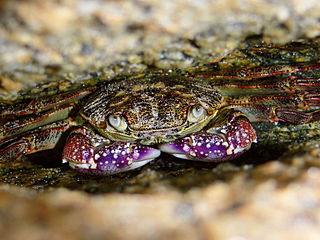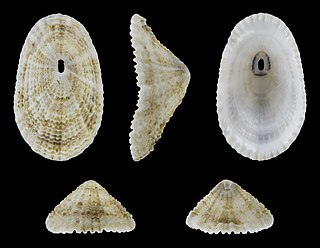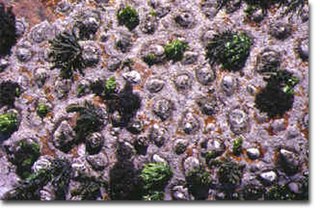
Limpets are a group of aquatic snails with a conical shell shape (patelliform) and a strong, muscular foot. This general category of conical shell is known as "patelliform" (dish-shaped). Existing within the class Gastropoda, limpets are a polyphyletic group.

Leptograpsus variegatus, known as the purple rock crab, is a marine large-eyed crab of the family Grapsidae, found in southern subtropical Indo-Pacific Oceans. It grows to around 50 millimetres (2.0 in) shell width. It is the only species in the genus Leptograpsus.

Fissurellidae, common name the keyhole limpets and slit limpets, is a taxonomic family of small to medium-sized limpet-like sea snails, marine gastropod molluscs in the clade Vetigastropoda.

Diodora is a genus of small to medium-sized keyhole limpet in the family Fissurellidae.

Diodora graeca, the Greek keyhole limpet, is a sea snail or limpet, a marine gastropod mollusk in the family Fissurellidae, the keyhole limpets.

Diodora italica, the keyhole limpet or Italian keyhole limpet, is a sea snail or limpet, a marine prosobranch gastropod mollusk in the family Fissurellidae, the keyhole limpets.

Fissurella is a genus of small to medium-sized sea snails or limpets, marine gastropod mollusks in the subfamily Fissurellinae of the family Fissurellidae, the keyhole limpets.

Scutellastra cochlear is a species of sea snail, a marine gastropod mollusc in the family Patellidae, one of the families of true limpets. It is commonly known as the snail patella, the pear limpet or the spoon limpet and is native to South Africa. It often grows in association with the crustose coralline alga Spongites yendoi and a filamentous red alga which it cultivates in a garden. It was first described by the malacologist Ignaz von Born in 1778 as Patella cochlear.

Diodora aspera, also known as the rough keyhole limpet, is a species of sea snail, a marine gastropod mollusk in the family Fissurellidae, the keyhole limpets. Although similar in appearance to a common limpet, it has a hole near the apex of its shell, and is only distantly related. It often has a scaled polychaete worm Arctonoe vittata living inside its shell as a commensal. In the event that it is attacked by a starfish, it extends flaps of mantle to defend itself, and the worm also helps drive the predator away.

Diodora funiculata is a species of sea snail, a marine gastropod mollusk in the family Fissurellidae, the keyhole limpets.

Diodora gibberula is a species of sea snail, a marine gastropod mollusk in the family Fissurellidae, the keyhole limpets.

Diodora minuta is a species of sea snail, a marine gastropod mollusk in the family Fissurellidae, the keyhole limpets.

Diodora viridula is a species of sea snail, a marine gastropod mollusk in the family Fissurellidae, the keyhole limpets.

Lucapina is a genus of sea snails, marine gastropod mollusks in the family Fissurellidae, the keyhole limpets.

Vasula deltoidea is a species of sea snail, a marine gastropod mollusk in the family Muricidae, the murex snails or rock snails.

Crepipatella dilatata is a species of sea snail described by Lamarck. It is a marine gastropod mollusk in the family Calyptraeidae, the slipper snails or slipper limpets, cup-and-saucer snails, and hat snails.

Dendrofissurella is a monotypic genus of minute deepwater keyhole limpets, marine gastropod mollusks in the family Fissurellidae, the keyhole limpets and slit limpets.

The subfamily Emarginulinae, common name keyhole limpets and slit limpets, is a taxonomic subfamily of limpet-like sea snails, marine gastropod molluscs in the family Fissurellidae, the keyhole limpets and slit limpets.

The subfamily Fissurellinae, common name the keyhole limpets and slit limpets, is a taxonomic subfamily of limpet-like sea snails, marine gastropod molluscs in the family Fissurellidae.




















